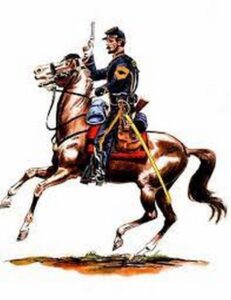
Many watched as a small parade went down dusty El Camino Real soon to be renamed Main St. in 1863. They were mounted cavalry, in blue, riding south from Santa Barbara to Fort Drum, in Wilmington for training. They were armed with 11-foot lances, each one with a little pennant attached to the steel points. They were all local men, Company C of the First Native Cavalry Battalion of the Union Army riding south to join in the American Civil War that had raged for three years. As the name of the Unit implies, It was made up of Latinos born in California.
The Yankees didn’t know it, but it was a diverse group with only Spanish language and Roman Catholic faith uniting them. They were Californios, Yaqui Tribesmen, Mission Indians, Chumash, Mexican Nationals, and a handful of Europeans (Spanish and French) all together in the first bi-lingual unit in the US Army. Two factors lead to the formation of this Battalion, A) a drought had caused many vaqueros to lose their jobs as cowboys as the great ranches turned to Sheep raising. and B) the need for more troops to help the Union cause in the Southwest. So, they signed up for a two year enlistment leaving wives and family in what is today Ventura and Santa Barbara.
Their lances were taken away and replaced with a sharps carbines. Each trooper got a colt revolver, a sword, and the carbine. They trained, learning to ride in formation, and charge on command before being sent to Fort Yuma, then across the Arizona deserts to Fort Mason, near the Mexican Border.
The Confederacy had long been driven out of Arizona Territory, but there was still an Apache uprising to quell and as internal problems in Mexico spilled over the border. France had occupied Mexico and installed the puppet Emperor Maximillian Hapsburg, deposing the legally elected President, Benito Juarez (His wife and ten children had fled to New York City and Juarez had met with Abraham Lincoln). Many in Mexico supported Juarez and fighting broke out between the two factions.
When the Civil War ended, they marched to Baja where a steamer took them to San Francisco to be mustered out and given back pay. When they returned to Santa Barbara they were given a parade on State St. and a fiesta with fireworks and a bull fight.
It isn’t known what celebrations were given to the boys from San Buenaventura, but many returned home to their wives and children. Many of these Latinos who served in this unit rest at Ventura’s Cemetery Memorial Park.
